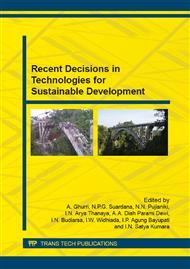p.3
p.9
p.17
p.24
p.30
p.36
p.41
p.47
The Development of Slurry Seal Design with Ordinary Portland Cement Replacement by Low Calcium Fly Ash
Abstract:
Slurry Seal is an impermeable non-structural thin layer that is used for pavement maintenance consisting of a cold laid mixture of asphalt emulsion with continuous graded fine aggregate, mineral filler, water and other added ingredients. Ordinary Portland Cement (OPC) as the main filler in the application of slurry seal. Due to the relatively high cement prices and the pollution control for the environment; it is required to maintain the quality of the slurry by using a combination of OPC and LCFA (Low Calcium Fly Ash). This research was conducted to determine the value of consistency, setting time and indirect tensile strength (ITS) of slurry seal containing LCFA. A consistency testing used to obtain optimum moisture content to produce the sample for the rest of the test. The results show that with the addition of 5% water for pre-wetting and subsequently 10% of water content, the mixture provide appropriate consistency as required by highways standard. The time settings also meet the requirements of highways standard between 15 to 720 minutes for all types of mixtures. The mixture with composition of 50% OPC and 50% LCFA is considered as an ideal mixture at the optimum density value of 1.769 g/cm3, porosity of 9.55% and the indirect tensile strength of 30.99 kPa. It could be concluded that fly ash can be used as OPC partial replacement and enhance the properties on slurry seal application.
Info:
Periodical:
Pages:
24-29
Citation:
Online since:
July 2015
Authors:
Keywords:
Price:
Сopyright:
© 2015 Trans Tech Publications Ltd. All Rights Reserved
Share:
Citation:


